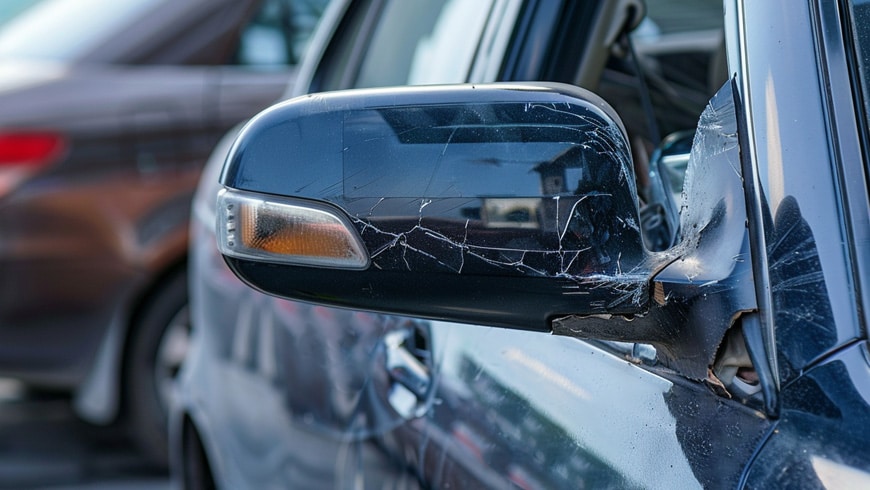So you broke your side mirror. It happens.
But the big question is: Will the damage be covered by your car insurance policy?
The answer, like many aspects of insurance, isn’t always straightforward. It depends on several factors, including the type of coverage you have and how the damage occurred.
Comprehensive Coverage: Your First Line of Defense
First things first: comprehensive coverage is your friend when it comes to broken side mirrors.
This optional add-on to your basic policy protects your vehicle from damage caused by events other than collisions.
But what exactly does that mean?
Imagine you wake up one morning to find your side mirror smashed. Perhaps a vandal decided to take out their frustrations on your car, or maybe a stray baseball from the neighborhood kids’ game went awry. In these cases, comprehensive coverage would typically come to your rescue.
It’s designed to cover damage from theft, vandalism, falling objects, and even animal encounters. (Ever heard of a deer totaling a car? It happens!)
Collision Coverage: For Those Tight Spots
But what if you accidentally clipped your mirror while backing out of a tight parking spot or your garage?
This is where collision coverage steps in. As the name suggests, it covers damage resulting from collisions with other vehicles or objects.
So, if you’re at fault for damaging your own mirror, collision coverage would typically foot the bill.

What Does the Policy Say?
Now, let’s get into the nitty-gritty of policy language. It’s not the most exciting read, but it spells out the types of things that are covered (and some things that are specifically not covered).
The ISO (Insurance Services Office) auto insurance policy form is a standardized document used by many insurers to outline the terms and conditions of auto insurance policies. Not all companies use the exact language included with the ISO form, but chances are good it’s very similar.
The ISO Personal Auto Policy form doesn’t specifically mention side mirrors. However, it does provide broad coverage for direct and accidental loss to your covered auto.
Under Part D – Coverage for Damage to Your Auto, the policy states:
“We will pay for direct and accidental loss to your covered auto or any non-owned auto, including its equipment, minus any applicable deductible shown in the Declarations.”
This broad language would typically include damage to side mirrors, whether it falls under comprehensive or collision coverage.
The Bare Minimum: Liability Coverage
But wait, there’s more! What if you only have the bare minimum liability coverage required by law?
In this case, you’re out of luck. Liability coverage protects you from damage you cause to others, not to your own vehicle.
It’s a reminder of why many insurance professionals recommend more than just the minimum coverage.
Situations Where Damage May Not Be Covered
There may be some situations where damage is not covered due to being specifically excluded by the language in your car insurance policy, or simply due to not having the right coverage in place.
1. Lack of Comprehensive or Collision Coverage
As just discussed, if you only have liability insurance, which is the minimum required in most states, your policy won’t cover damage to your own vehicle, including broken side mirrors. This applies regardless of how the damage occurred.
2. Intentional Damage
Did you break your mirror on purpose? Perhaps out of frustration or to stage an insurance claim? Insurance policies typically exclude coverage for intentional damage caused by the policyholder.
3. Wear and Tear
If your side mirror falls off or breaks due to age, rust, or general deterioration, your insurance likely won’t cover it. These issues fall under normal wear and tear, which is excluded from most policies.
4. Pre-existing Damage
If your side mirror was already damaged before you bought insurance, and you file a claim for it later, your insurer will likely deny the claim. This is why insurers often require vehicle inspections before issuing policies.
5. Damage Below the Deductible
While technically covered, if the cost to repair or replace your side mirror is less than your deductible, you’ll have to pay for it out-of-pocket. In this case, it’s as if you didn’t have coverage for that specific incident.
6. During Excluded Activities
Some policies exclude coverage when the vehicle is being used for certain activities. For example, if you’re using your personal vehicle for commercial purposes without appropriate coverage, damage incurred during these activities might not be covered.
8. Damage During Racing or Off-Roading
Many insurance policies exclude coverage for damages that occur while the vehicle is being used for racing, off-roading, or other activities not considered normal driving.
9. Lapse in Coverage
If your insurance policy has lapsed due to non-payment or cancellation, any damage that occurs during the period without active coverage will not be covered.
The Bottom Line
If you have comprehensive or collision coverage, a broken side mirror is likely covered. But don’t forget about your deductible!
As mentioned, if the cost to repair or replace the mirror is less than your deductible, you’ll be paying for the full repair out-of-pocket.
And here’s a pro tip: before filing a claim, consider the potential impact on your premiums. Sometimes, it might be more cost-effective in the long run to pay for minor repairs yourself rather than risk a rate increase.
If your deductible is $500 or less, chances are that the repair cost will exceed your deductible, but a lot of that depends on the vehicle you drive.
Even if the cost of an OEM replacement mirror is under $300, you could easily double that amount for paint prep, paint matching, and removal of the old mirror and installation of the new one at your local auto body shop.
If your deductible is $1,000 or more, there is a good chance you’ll have to cover the entire repair cost out of your own pocket.
 During his career as an independent insurance agent,
During his career as an independent insurance agent,